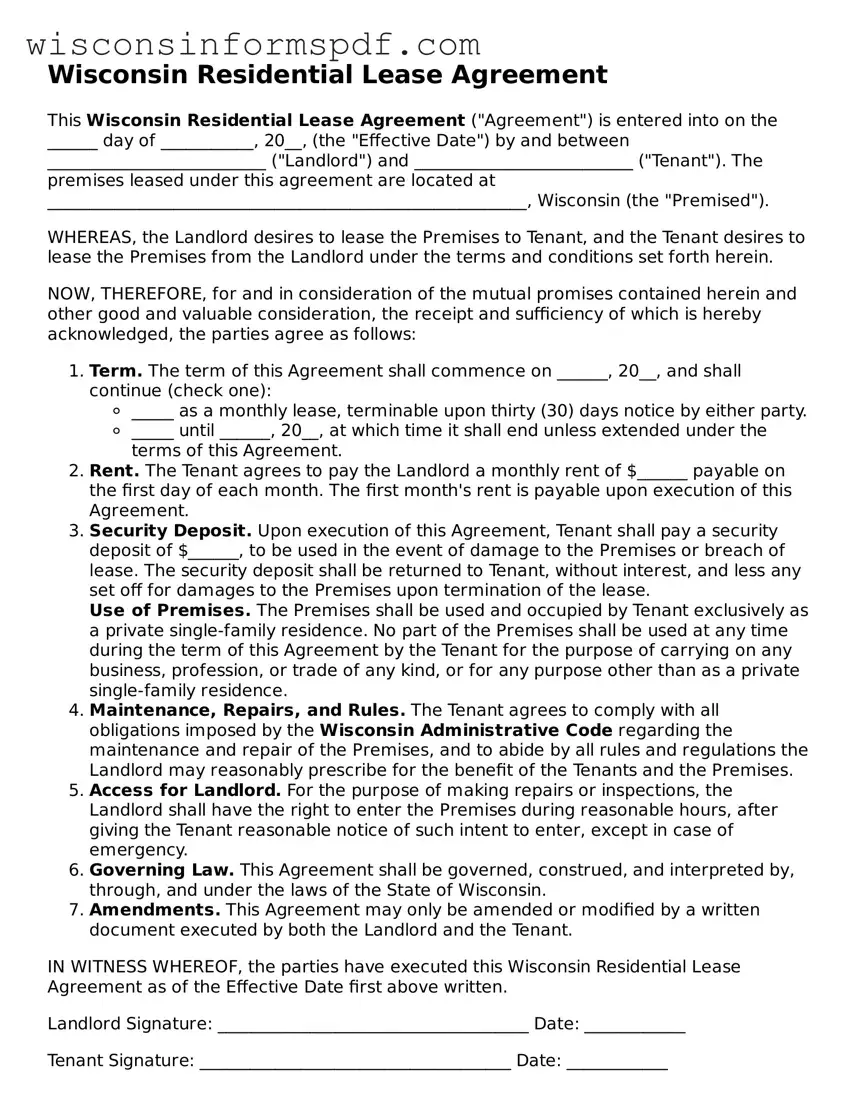What is a Wisconsin Residential Lease Agreement?
A Wisconsin Residential Lease Agreement is a legally binding document between a landlord and a tenant that outlines the terms and conditions of renting residential property in Wisconsin. This agreement specifies the rights and responsibilities of both the landlord and the tenant, including rent payment, security deposit details, property use limitations, and maintenance responsibilities.
How long does a standard Wisconsin Residential Lease Agreement last?
Most standard Wisconsin Residential Lease Agreements are set for a fixed term of 12 months. However, the duration can vary based on mutual agreement between the landlord and the tenant. Terms for shorter periods or month-to-month arrangements can also be established.
Are security deposits required in Wisconsin?
Yes, in Wisconsin, landlords may require security deposits from tenants. These funds serve as financial protection for the landlord in case of unpaid rent or damage to the property. Wisconsin law stipulates that a landlord must return the security deposit within 21 days after lease termination, minus any deductions for damages beyond normal wear and tear.
What should be included in a Wisconsin Residential Lease Agreement?
A comprehensive Wisconsin Residential Lease Agreement should include the following details: identification of the parties involved, property address, rental term, amount of rent and security deposit, payment terms, conditions for renewal or termination, responsibilities for repairs and maintenance, restrictions on use of property, and any other conditions or rules pertinent to the lease arrangement.
Can a tenant sublet the rental property in Wisconsin?
Whether a tenant can sublet the rental property depends on the terms of the Lease Agreement. Landlords can include clauses that permit or prohibit subletting. If the agreement allows for subletting, tenants are typically required to obtain the landlord’s approval before proceeding.
What happens if a tenant breaks a lease agreement early in Wisconsin?
If a tenant breaks a lease early in Wisconsin, the landlord has the right to seek damages that may include the cost of lost rent until the property is re-rented, advertising costs, and any other expenses directly related to the lease breach. Wisconsin law obligates landlords to make reasonable efforts to re-rent the property to mitigate damages.
How is a Wisconsin Residential Lease Agreement terminated?
A Wisconsin Residential Lease Agreement can be terminated at the end of the fixed term if either party chooses not to renew. For month-to-month tenancies, typically a 28-day notice is required from either the landlord or the tenant to terminate the lease. Early termination clauses may be included in the lease, specifying conditions under which the agreement can be ended prematurely.
Are pets allowed in rental properties in Wisconsin?
The allowance of pets in rental properties in Wisconsin is at the discretion of the landlord. A lease agreement can include clauses that permit pets, restrict certain types or breeds of pets, or prohibit pets entirely. Additional deposits or monthly fees for pets can also be stipulated in the agreement.
